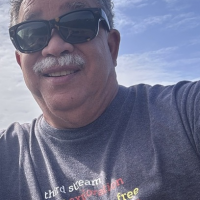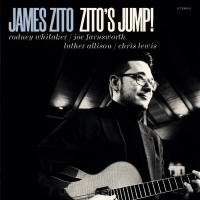Home » Jazz Musicians » Robert Cray
Robert Cray
Robert Cray - electric guitar, vocals, recording artist
Robert Cray is one of the few blues artists who managed to cultivate a mainstream following from the get go. In the course of a long-running career that began in the 1970s, he uniquely blended elements of rhythm and blues, pop, and traditional blues to win fans to a more contemporary blues sound. Cray, who obviously is respected in blues circles, is a press darling and crossover smash. While achieving critical acclaim, Cray made no apologies for his more popular music, and he's been rewarded with four Grammy Awards for his innovative style.
Born on August 1, 1953, Cray did not have the typical upbringing of a blues musician. Cray's middle-class childhood as an "Army brat" stood in stark contrast to the impoverished Southern beginnings and Northern ghetto lifestyles of many blues greats. Like many children of military personnel, Cray spent his formative years moving from one location to another, starting in Columbus, Georgia, where he was born. The constant uprooting made Cray a shy, introverted child; when he convinced his mother to buy him a guitar, he found solace in music as one of the few permanent things in his life. Cray had a number of musical influences, gleaned from his father's voluminous record collection which included gospel, rhythm and blues, jazz, and traditional blues. He also picked up on the Beatles craze in the 1960s. He practiced diligently and joined a band while in high school in Newport News, Virginia. The family eventually settled in Tacoma, Washington.
Cray had some training as a classical pianist as a child, but his first serious musical expression was an eclectic mix of rock and roll and rhythm and blues. However, he discovered the music of blues greats Muddy Waters and Howlin' Wolf while searching for inspiration in his father's record collection, and from that point on, he was hooked on the blues. Cray tried to communicate this passion to his classmates, even going so far as to convince them to book blues musician Albert Collins for their graduation party. Cray's association with Collins later proved instrumental to his career. In 1969, Cray found a kindred spirit in Richard Cousins, a local musician. The two of them embarked on a study of the blues while playing together in Tacoma bars. Their findings influenced the development of their own music, and they traveled to Eugene, Oregon, in the hopes of finding success in the progressive college town. The Robert Cray Band hit the bar circuit with Tom Murphy on drums, and Cray as frontman on vocals and guitars. Cray was still very much an introvert at this time, and his stage-fright caused his teeth to chatter so badly that Cousins had to introduce each song to their audiences.
Read moreTags
John Lee Hooker: The Best of Friends

by Doug Collette
In contrast to his often (always?) irascible peer Chester Burnett, aka Howlin' Wolf, John Lee Hooker has long been amenable to collaborations, reciprocal and otherwise. Bonnie Raitt, Los Lobos, Charlie Musselwhite and Carlos Santana, among others, appeared on The Healer (Chameleon,1989) and all those artists also populate the credits for The Best of Friends. (Santana, the Mexican-born guitar hero, appears with two different iterations of his band). Fittingly titled, this anthology is a suitable companion piece to Whiskey ...
Continue ReadingVarious artists: Alligator Records: 50 Years of Genuine Houserockin’ Music

by Jim Trageser
Maybe this half-century commemoration of the Chicago-based, blues-focused label should have been titled, “The Last of the Independents." Almost alone of the mid-major labels that formerly thrived in the 1980s and '90s by specializing in non-mainstream styles of music, Alligator has managed to navigate stunning changes in the music business--from the vinyl of LPs and 45s to cassettes and CDs, and then, most recently, the virtual collapse of the retail record business and wholesale pivot to online digital ...
Continue ReadingRobert Cray: Shoulda Been Home

by Al Rearick
Who says sticking to a proven formula is a bad thing?
For those of you who thought Cray’s last effort was a nice sizzling slab o’ soul, his follow-up continues the tradition. Shoulda Been Home picks up where Take Your Shoes Off left off, and carries the groove forward in a manner that would have made the folks at Stax proud. In fact, Cray and the band proudly display such influences on most of the tracks here.
A word of ...
Continue ReadingRobert Cray: Take Your Shoes Off

by AAJ Staff
If ever a title captured the mood of an album, this is it. Take Your Shoes Off, Cray's latest release from Ryko, is a bit of a departure from what we might expect from Robert and his band. The album flows effortlessly from beginning to end, allowing us to listen to it in it's entirety; a true phenomenon these days. The track list here, as the title suggests, is composed mostly of bright melodic tunes, but that's not to say ...
Continue ReadingRobert Cray Band Replaces Gregg Allman at Bluestock

Source:
JamBase
ROBERT CRAY BAND REPLACES AILING GREGG ALLMAN Bluestock is excited to announce the addition of the Robert Cray Band to the festival's inaugural lineup, following the cancellation of the upcoming Gregg Allman tour. Upon his doctor's orders, Gregg Allman is unfortunately being forced to cancel his August 26 through September 15 concert dates due to an upper respiratory condition. Treatment is going to involve several days of hospitalization and 4 weeks of bed rest at home. Allman continues to recover ...
read more
Something Else! Reviews on the 2011 Blues Hall of Fame Honorees

Source:
Something Else!
By Something Else! Reviews Robert Cray tops this year's class of inductees into the Blues Hall of Fame. He's joined by acoustic bluesman John Hammond; soul-blues belter Denise LaSalle, 1950s singing star Big Maybelle, and singer/songwriters Alberta Hunter and J.B. Lenoir. Also to be recognized: Vivian Carter and Jimmy Bracken (the “Vee" and “Jay" in Vee-Jay Records), noted African-American educator John W. Work III, writer Samuel Charters and producer Bruce Bromberg, who's worked with Cray and Joe Louis Walker, among ...
read more
Jazz Musician of the Day: Robert Cray

Source:
Michael Ricci
All About Jazz is celebrating Robert Cray's birthday today!
JAZZ MUSICIAN OF THE DAY Robert Cray
Robert Cray - electric guitar, vocals, recording artist Robert Cray is one of the few blues artists who managed to cultivate a mainstream following from the get go. In the course of a long-running career that began in the 1970s... more
Website | Videos | Articles
Follow Robert Cray
Put AAJ's Musician of the ...
read more
Robert Cray Band Readies 'Live From Across The Pond,' First Live Album in 30+ Year Career, Set for September 12 Release

Source:
All About Jazz
Five-Time Grammy Award Winning Artist To Tour With Eric Clapton This Fall
The Robert Cray Band is famous for touring more than six months out of every year. Yet in their 30+-year career, there has never been a live album--until the imminent release of Live From Across The Pond, that is. The two-CD live set was recorded over the course of seven shows in May 2006 at London's Royal Albert Hall while Cray was on tour with Eric Clapton.
Still ...
read more
Robert Cray's "Twenty" Depicts Disillusioned Soldier; Streaming Audio at TrueMajority.org

Source:
All About Jazz
Song to be Made Available as Streaming Audio at TrueMajority.org, Non-Partisan Advocacy Organization Founded by Ben Cohen LOS ANGELES, CA – The Robert Cray Band’s forthcoming album Twenty is set for release on a week bookended by the May 24 birthday of one of this generation’s most eloquent protest songwriters, Bob Dylan, and by Memorial Day, May 30. The dates are significant when one considers the subject matter which defines the album’s title track, “Twenty.”
“The song is about an ...
read more
Robert Cray in Philadelphia on June 4 w/ B.B.King -- New CD

Source:
All About Jazz
LOS ANGELES – The Robert Cray Band, notched its 1,000th live performance as a unit at the beginning of 2005, just after completing their new album, Twenty. The new album combines the band’s skills with legendary, Grammy winning engineer Don Smith (The Rolling Stones, Ry Cooder, Miles Davis) to craft an intelligent and sophisticated CD that draws from a diverse pool of influences to create a signature sound and a varied menu of songs.
Twenty, like its predecessor Time Will ...
read more



































